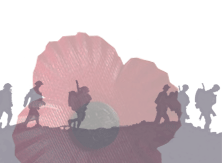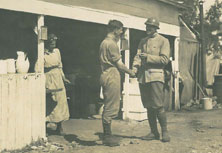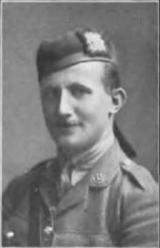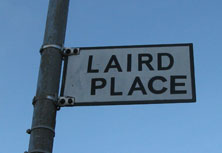The Laird Family



 Their names will be remembered for evermore
Their names will be remembered for evermore
It is fitting that a family whose skills ran from cabinetmakers to architecture should have had a street named after them. The Lairds were well-known in Bridgeton as master carpenters and owners of a sawmill. During the war they put a variety of skills to use in local and military life. By the turn of the century, the joinery firm George Laird founded in 1857 employed nearly 100 men and boys. He had nine children; four of his sons entered the professions of architecture, engineering and medicine. Thomas trained as a doctor in Glasgow, and became a major in The Royal Army Medical Corps. Others remained at the helm of the company, and one of them, Matthew, was apprenticed as a joiner. Matthew spent several years with the Queen's Own Yeomanry at the start of the century. At the outbreak of war, aged 39, he re-enlisted, and became an officer in the Lowland Division of The Royal Engineers. In June 1915, his unit landed at Gallipoli, where he was promoted to captain. A chance meeting Matthew's sister Mary volunteered with the Scottish Women's Hospital. From May 1915 she served with the Girton and Newnham Unit at a field hospital in Troyes, France. That autumn, the French Expeditionary Force asked the hospital to accompany them to Greece. During the voyage, Mary and Matthew met by chance in Malta, where Matthew was recuperating from an illness. It was probably the last time they saw each other: Matthew was evacuated to Egypt at the start of 1916 and died fighting at Kantara on 23 April. Their brother George, who had followed Matthew into the family business, had three sons. George Jr, who had trained as a solicitor, joined the 6th Battalion, The Highland Light Infantry. He was sent to Egypt and left for the Dardanelles in June 1915, where he was badly wounded at Gallipoli. He was recuperating in Glasgow when he heard of the death of Arthur, his brother. Arthur had worked with the timber firm as a surveyor before joining the 17th (Chamber of Commerce Battalion, The Highland Light Infantry. The British Army's worst day Arthur was killed on the first day of the Somme - 1 July, 1916. It would claim notoriety as the British Army's worst day, killing 20,000 among 60,000 casualties. After a week of bombardment, the plan had been for the British to walk across no man's land and seize the devastated German lines. But the Germans, who had an advanced bunker system, simply waited out the attack. When the shelling was over, they came out and set up position. As the British divisions advanced, the machine guns started. Sixty per cent of all officers involved on the first day were killed. The 17th Battalion's chaplain, the Rev Gray, wrote of "the merciless gunfire... it mowed them down like rabbits". Family name lives on The rest of the family survived the war. Arthur's other brother William, who served with The Royal Field Artillery in Palestine, retired as a lieutenant colonel and resumed business in Glasgow, as did George. Their uncle, Thomas, went on to practise medicine in Cambuslang. The family left its mark on Glasgow's buildings, with architects James and John - two of the first George Laird's nine children - working on Scotstoun Flour Mills, St Catherine's Leather Works in Ingram Street, and Bridgeton's Star Palace Cinema. When George Laird and Son moved from Ann Street to larger premises in 1917, the firm left a site it occupied for 60 years. Ann Street was renamed Laird Street, and although it was demolished, the family's history in the area lives on in Laird Place. View the original referenced text here: |
Images:
|











